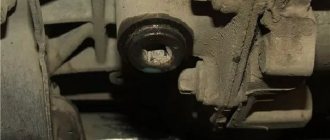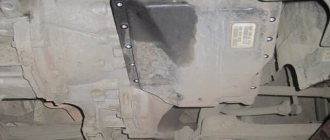If you notice that your automatic transmission has started to twitch and shift late, then this is not yet a reason to panic. Sometimes it’s enough just to wash it and change the oil, but it’s important to do this procedure correctly. Today at car services there are many mechanics who, instead of a complete oil change, do a partial oil change, so now we will figure out how to correctly change the oil in an automatic transmission.
No matter what the instructions say, there is a universal rule - change the transmission oil every 40,000 km. It is also important to remember that there are 2 options for changing the oil in an automatic transmission:
- partial oil change;
- complete oil change in automatic transmission.
What is gear oil, its role in the gearbox
Transmission oil helps avoid rapid wear of parts that are subject to excessive friction.
Most often, such oils are intended for drive axles and manual transmissions. Transmission fluid differs from other lubricants in that it creates a stable film on gearbox parts that can withstand heavy loads and remove excess heat and noise from gear parts.
However, gear oil is not used in all cases. Manufacturers of front-wheel drive passenger cars, in which the gearbox is combined with the final drive, strongly recommend the use of motor oil.
Do I need to change the oil in a manual transmission?
A manual transmission is an important and complex vehicle unit that occasionally requires maintenance to ensure normal functioning and long-term operation without repair.
Reasons why it is necessary to change the oil in a manual transmission:
- after a sufficiently long period of time, chips form, and the manual transmission does not have a filter;
- over time, due to temperature and mechanical influences, the transmission fluid loses its beneficial properties (foams, viscosity changes, lubrication efficiency decreases, additives precipitate);
- chips in oil and/or a decrease in useful properties lead to increased wear of parts and premature repairs.
Reasons for changing the gearbox oil
Gear oil contains several types of additives and a base. During operation, over time, the oil loses its physical properties and is not able to protect the components of the transmission.
The temperature of the transmission oil during engine operation reaches 150°C.
Under conditions of frequent travel and extreme driving, old oil foams and transmits torque poorly. Additives do not withstand mechanical stress and do not protect the transmission. Carbon deposits settle on bearings and washers, impairing gear shifting speed.
While driving, the gearbox with old oil hums, and after some time of driving like this, the gear teeth begin to collapse. As a result: gears do not shift clearly, switch off on their own, and scuffing of the main gear and differential gears occurs.
Old oil is especially dangerous in winter. Since the oil is thick at low temperatures after the engine is ignited, the gearbox runs dry. In the case of high-quality oil, after the previous start, an oily film remains on the gears, the properties of which will last as long as the oil circulates through the hydraulic system. Used oil simply loses its lubricating properties and, after completion of the work, goes into the pan, leaving no film for subsequent work.
In automatic transmissions, untimely oil changes can lead to leakage of the oil seal input shaft. If it goes unnoticed, the gearbox will jam.
Oil loses its properties under different conditions: changes in ambient temperatures, winding mountain road surfaces, extreme driving style. On average, you need to change the oil every 40–50 thousand kilometers, in extreme driving conditions after 15–30 thousand km.
Car manufacturers may not indicate when it is necessary to change the oil and give a full guarantee of its performance. However, it must be taken into account that in Europe vehicles are used for 3–5 years, in Japan for 100 thousand km. During this time, the oil, if used correctly, will not have time to become unusable and does not need to be replaced. In Russia, in turn, cars are used for up to several decades and it is important to understand the need to change the oil in the gearbox after the warranty expires.
Replacement methods
Recently, changing the oil in an automatic transmission has been done in two ways. They enable the car to travel many more kilometers, but the first method is not entirely suitable, since it only replaces about 40% of the oil.
- Oil refreshment . The replacement process is carried out by draining the old oil through the drain hole in the box. Then the plug is screwed in and fresh fluid is poured into the automatic transmission. In this case, the liquid in the box is partially refreshed, since some amount of oil remains in the box. It is better to carry out this process after 100 km.
- Professional replacement . This process is carried out in a special center for replacing fluids and oils by professional craftsmen. They use special equipment that makes it possible to completely clean the gearbox crankcase of old dirty oil and flush the channels before filling in new oil. This process is accompanied by replacing the pan gasket and automatic transmission oil filter.
Despite the simplicity of replacement, this is a very tricky procedure. There is a risk that the automatic transmission will fail due to incorrect replacement. Today there are many different organizations that provide replacements for free, provided you purchase oil from them.
There is no torque converter in the CVT box; the power is transmitted through a chain or belt, so changing the oil is much easier, can be replaced in a shorter time, and the replacement frequency is reduced.
Types of gear oils
There are three main types of hydraulic fluid:
- Mineral;
- Synthetics;
- Semi-synthetic.
In general, regarding gears and gearboxes, there is no significant difference between mineral and synthetic bases. Mineral oil served as the basis for the creation of synthetics, due to the need to use additives and additives. As a result, synthetic oil lasts longer than mineral oil. Anti-scuff additives contain sulfur molecules, which, under conditions of increased load, react and form modifications of the metal.
Semi-synthetics are used for reinforced transmission mechanisms and in structures where EP characteristics are required.
Do-it-yourself oil change for a Chevrolet Lacetti
14.12.2015
Do-it-yourself oil change for a Chevrolet Lacetti
Every 10,000 km, a mandatory oil change for the Chevrolet Lacetti is recommended. At the same time, solving this issue requires an individual approach, since the operating conditions for each vehicle are different. There are often cases when the oil is changed much more often due to difficult road conditions and increased load on the vehicle.
Changing the Chevrolet Lacetti oil yourself is accessible even to a novice car owner. The main thing is to choose the right type of engine oil. To do this, refer to the operating instructions for the machine.
You will also need to purchase an oil filter, a special removable wrench for it and a 17” wrench for unscrewing the drain plug.
Although, if you do not often change the oil in your Chevrolet Lacetti, then you don’t have to buy a key; you can try to unscrew the oil filter by hand or, as was done on old VAZs, take a thick screwdriver and pierce the filter housing with this same screwdriver, and using it As a lever, twist the filter counterclockwise.
The car is installed strictly horizontally
As a rule, changing the Chevrolet Lacetti oil is done on a warm engine, so all manipulations should be carried out carefully so as not to get burned
The first step is to open the engine filler cap to fill the oil. Place a container in the place where the used oil is drained and carefully unscrew the drain plug, from which hot oil will begin to pour out.
After it has drained, you can begin to remove the oil filter.
Unscrew the drain plug
Unscrew the old oil filter
Chevrolet Lacetti oil filter - article number, engine oil volume 1.4, 3.8 liters.
Before installing a new filter, you need to lubricate its threads and O-ring with oil, and then install the filter by hand. The next step is to tighten the drain plug
It is important to know that its sealing ring on the drain plug is disposable and therefore must be replaced, otherwise oil leakage will occur
Chevrolet Lacetti oil filter
Gasket for Chevrolet Lacetti drain plug Chevrolet Lacetti
Now you can start filling the engine oil. It is recommended to use a funnel. Overfilling of oil is not allowed. The oil volume in the Chevrolet Lacetti is 1.4 liters and 3.8 liters. The oil level should be below the max mark.
Screw on the neck cap and start the engine. It is necessary to monitor the oil pressure. Approximately 5-7 seconds after starting, the warning light on the instrument panel should go out. After five minutes of work, turn off the engine, wait a few minutes, remove the oil dipstick and check the oil level. It should be located midway between the min and max marks.
Finally, we inspect the new filter and drain plug. The absence of traces of leaking oil will indicate that the Chevrolet Lacetti oil has been changed.
2015 Chevrolet Malibu
How to change transmission oil
It is best to change the oil on a lift or inspection pit. If there is neither one nor the other, you can get by with jacks. Among the tools, be sure to prepare a syringe and several containers for the used liquid in advance.
You need to start changing the oil with a short drive of 10–15 km. This will allow the oil to warm up and flow through the entire hydraulic system to achieve the required fluidity. After checking in, it is better to leave the car for 15 minutes. In order not to waste time, you can immediately install the car on a lift or jacks.
Unscrew the oil filler cap. It would be more advisable to immediately check all seals and gaskets, and if they are unsuitable for further use, immediately replace them. After checking, you must carefully open the drain plug and allow the liquid to drain completely.
After removing the used lubricant, the hole is closed. Since the filler hole is quite small, new transmission oil is poured using a syringe to the level of the lower edge.
How to change gearbox oil and when to change it
So, the main types of gearboxes:
- mmmechanical (manual transmission);
- automatic (automatic transmission);
- robotic (manual transmission);
- CVT (variator CVT).
At the same time, mechanics and hydromechanical automatic remain the most common. For all types of gearboxes, transmission oil is used; it is this that ensures optimal lubrication of shafts, gears and other gearbox mechanisms.
Moreover, unlike mechanics, in an automatic transmission the transmission oil in the form of ATF fluid is working, since torque from the internal combustion engine is transmitted through it to the torque converter, and the operation of the box is also controlled thanks to the supply under pressure through the channels in the valve body.
Regarding the question of when to change the gearbox oil, a manual transmission requires less frequent maintenance during operation. On average, after 80-100 thousand kilometers the car will require replacement of the clutch disc, and every 80 thousand kilometers it will be necessary to change the oil.
In an automatic transmission, changing the oil and filter element must be carried out more often (on average, at a mileage of about 50-60 thousand km.) In both the first and second cases, changing the oil in the gearbox must be carried out on time, as this will cause depend on the resource of the car's manual or automatic transmission.
Changing the gearbox oil
There are several options for changing gearbox oil. This is a partial oil change in an automatic transmission, during which about 40-50% of the transmission fluid is renewed, as well as a complete replacement in both manual and automatic transmissions.
Replacing transmission fluid in an automatic transmission is often carried out using a special device. In this case, the method of displacing used transmission fluid is used. In this case, the transmission fluid is almost completely renewed.[/do]
The oil can be changed either independently or with the help of qualified specialists at a service station, while changing the oil in the gearbox with your own hands will cost the vehicle owner significantly less.
How to change oil: mechanics
Before changing the oil, it is necessary to warm up the manual transmission. Replacement should be carried out in a room with a positive temperature in the presence of a pit or an automatic lift.
Stages of changing the oil in a manual transmission:
- Place the car on the inspection pit or lift it using an automatic lift;
- Prepare a container for draining the waste liquid;
- Unscrew the oil filler plug and check the condition of the O-ring;
- Unscrew the drain plug and drain the used oil into a previously prepared container.
- Tighten the drain hole.
- Pour oil into the oil filler hole using a syringe or funnel to the level of the lower edge.
- Tighten the oil drain plug.
It should be noted that not all manual transmissions have a separate drain plug. The fact is that the box is positioned by many manufacturers as a maintenance-free unit (designed for the entire service life of the car).
However, in practice, an oil change is necessary. In such a case, the oil can only be drained from a manual transmission by removing the pan. By the way, to understand how much oil to pour into a manual transmission, you need to separately study the manual for the car. When changing the oil in the box, the level is controlled using a control hole, which is usually found on most gearboxes.
How to change the oil in a gearbox: automatic
Transmission fluid in automatic transmissions is more susceptible to aging and requires partial or complete replacement. A complete or partial oil change in an automatic transmission involves “renewing” the oil or replacing it in full.
During a partial replacement, on average, only half of the transmission fluid is removed from the system. Part of the waste fluid remains in the internal cavities of the automatic transmission, gas turbine engine and cooling radiator.
A complete fluid change in an automatic transmission is carried out by removing the transmission sump or using a special device that simultaneously drains the old oil and pumps in new oil (up to 95% of the lubricant is renewed).
Let's consider the option of a complete oil change without using a special device. The main stages of a complete oil change in an automatic transmission:
- The car is placed on a viewing hole or raised using a lift.
- A container is prepared to drain the waste liquid.
- Remove the automatic transmission oil sump.
- The supply hose is disconnected from the transmission fluid radiator fitting and lowered into the prepared container. The selector lever moves to the “N” (neutral) position.
We also recommend reading the article on how to check the oil level in an automatic transmission. From this article you will learn about the subtleties and nuances when checking the level of transmission fluid in an automatic transmission, why the level should not be exceeded or decreased above the recommended level, what the oil in the transmission should be, etc.
- Next, you need to start the engine and drain the used transmission fluid.
- After turning off the engine, unscrew the drain plug, remove any remaining transmission fluid, and then tighten the plug.
- Using a special funnel, you will need to pour fresh liquid into the filler hole (on average, for passenger cars 5.5 liters).
- You will also need to add some transmission oil through the supply hose.
- Start the engine and drain approximately 3.5 liters of fluid, then turn off the engine and refill fluid through the supply hose. Repeat the procedure 2-3 times.
- Fill the automatic transmission with transmission fluid in the volume specified by the manufacturer of this transmission. At the same time, the total volume of oil in the automatic transmission and the service volume may differ.
Functions of transmission oil, what is the difference between engine and transmission oil
Most car owners know about the need to regularly change engine oil. But what is usually forgotten is that the gearbox oil also wears out over time and should be replaced to avoid damage to the transmission. Which, ultimately, will cost much more than changing the oil in the gearbox.
This is interesting: Vacuum cleaner for cars - choosing the optimal cleaning device











